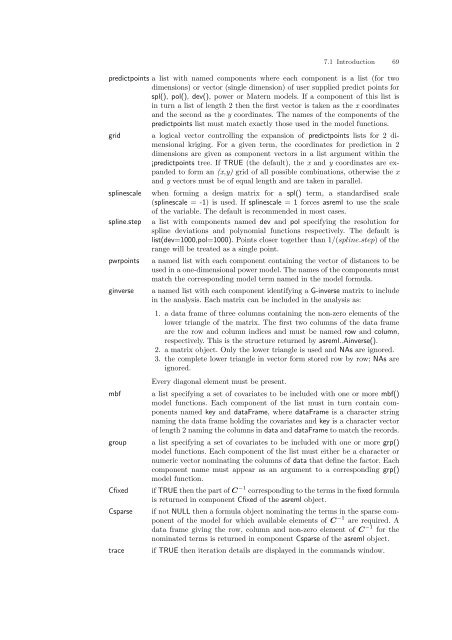ASReml-S reference manual - VSN International
ASReml-S reference manual - VSN International
ASReml-S reference manual - VSN International
- No tags were found...
Create successful ePaper yourself
Turn your PDF publications into a flip-book with our unique Google optimized e-Paper software.
7.1 Introduction 69predictpoints a list with named components where each component is a list (for twodimensions) or vector (single dimension) of user supplied predict points forspl(), pol(), dev(), power or Matern models. If a component of this list isin turn a list of length 2 then the first vector is taken as the x coordinatesand the second as the y coordinates. The names of the components of thepredictpoints list must match exactly those used in the model functions.gridsplinescalespline.steppwrpointsginversembfgroupCfixedCsparsetracea logical vector controlling the expansion of predictpoints lists for 2 dimensionalkriging. For a given term, the coordinates for prediction in 2dimensions are given as component vectors in a list argument within the¡predictpoints tree. If TRUE (the default), the x and y coordinates are expandedto form an (x,y) grid of all possible combinations, otherwise the xand y vectors must be of equal length and are taken in parallel.when forming a design matrix for a spl() term, a standardised scale(splinescale = -1) is used. If splinescale = 1 forces asreml to use the scaleof the variable. The default is recommended in most cases.a list with components named dev and pol specifying the resolution forspline deviations and polynomial functions respectively. The default islist(dev=1000,pol=1000). Points closer together than 1/(spline.step) of therange will be treated as a single point.a named list with each component containing the vector of distances to beused in a one-dimensional power model. The names of the components mustmatch the corresponding model term named in the model formula.a named list with each component identifying a G-inverse matrix to includein the analysis. Each matrix can be included in the analysis as:1. a data frame of three columns containing the non-zero elements of thelower triangle of the matrix. The first two columns of the data frameare the row and column indices and must be named row and column,respectively. This is the structure returned by asreml..Ainverse().2. a matrix object. Only the lower triangle is used and NAs are ignored.3. the complete lower triangle in vector form stored row by row; NAs areignored.Every diagonal element must be present.a list specifying a set of covariates to be included with one or more mbf()model functions. Each component of the list must in turn contain componentsnamed key and dataFrame, where dataFrame is a character stringnaming the data frame holding the covariates and key is a character vectorof length 2 naming the columns in data and dataFrame to match the records.a list specifying a set of covariates to be included with one or more grp()model functions. Each component of the list must either be a character ornumeric vector nominating the columns of data that define the factor. Eachcomponent name must appear as an argument to a corresponding grp()model function.if TRUE then the part of C −1 corresponding to the terms in the fixed formulais returned in component Cfixed of the asreml object.if not NULL then a formula object nominating the terms in the sparse componentof the model for which available elements of C −1 are required. Adata frame giving the row, column and non-zero element of C −1 for thenominated terms is returned in component Csparse of the asreml object.if TRUE then iteration details are displayed in the commands window.
















